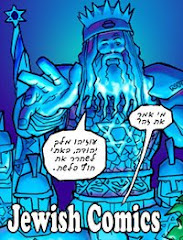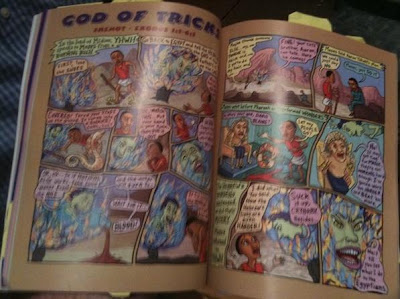This weekend, readers, writers, artists, publishers and fans of comix will converge at the Toronto Reference Library to take part in the the FREE Toronto Comic Arts Festival.
Among the talented people who will be at TCAF this year are a small number of comix professionals who have done work that has already been mentioned at the Jewish Comics Blog.
* Willow Dawson, a talented Canadian artist, who has illustrated the anthology No Girls Allowed : Tales of Daring Women Dressed as Men for Love, Freedom and Adventure, written by Susan Hughes & published by Kids Can Press. The anthology includes the story of Esther Brandeau, the first Jewish person to immigrate to Canada.
* Sarah Dyer, who has co-written the following : "The Gift of the Maccabees" (in The Simpsons Winter Wing Ding #1 ; "One-Punch Goldberg" (in Biff Bam Pow! #1 ; the one-page comic "How to Cook a Gentile" (Heeb #15)
* Evan Dorkin, who has written or co-written the following : "The Gift of the Maccabees" (in The Simpsons Winter Wing Ding #1 ; "One-Punch Goldberg" (in Biff Bam Pow! #1 ; the one-page comic "How to Cook a Gentile" (Heeb #15) and "The Soda Thief" (in Streetwise : Autobiographical Stories by Comic Book Professionals)
* Sammy Harkham, author-illustrator of "Lubavitch, Ukraine 1876", which appeared in Kramer's Ergot #6
* Miriam Libicki, author-illustrator of the jobnik! series, the first volume of which has been collected in trade paperback, the illustrated essays "Towards a Hot Jew: The Israeli Soldier as Fetish Object" and "Jewish Memoir Goes Pow! Zap! Oy!" & the illustrated mini-journals Ceasefire and Fierce Ease.
* David Malki!, author of the Wondermark webcomic, which has been collected in trade paperback. Among the comics that have appeared on the site is one with the punch line "Hannukah bush", one about the Jewish New Year, one that uses the juice/Jews homonym joke and one about Hebephiles
* Jim Ottaviani, author of Wire Mothers: Harry Harlow and the Science of Love and Fallout : J. Robert Oppenheimer, Leo Szilard, and the Political Science of the Atomic Bomb
* Paul Pope, author-illustrator of the story "Berlin Batman" in The Batman Chronicles #11 (reprinted in Batman : Year 100), in which Batman is a Jewish painter named Baruch Wane.
* Jonathan Rosenberg, author-illustrator of the webcomic Goats, which includes the Jewish character "Jon", as seen in the strip from Nov. 24, 2005
* James Sturm, author-illustrator of The Golem's Mighty Swing and Market Day
*******
Panels these creators will be at
Comics as Art Objects: Form vs Function
Saturday, May 8th, 10:45 – 11:30am, Novella Room
Screenprinted; hand-sewn; individually colored; hand-done die-cuts — some comics are created as art objects in and of themselves. How does this focus on the comic as an art object affect the stories comics tell? Join cartoonists Willow Dawson, Lizz Lunney, Alexis Frederick-Frost, Matt Swanson, Robbi Behr, and Matt Wiegle to answer these questions and raise many more! Moderator TBD.
Feature: Daniel Clowes, James Sturm, Seth, Chester Brown, and Jim Woodring
Saturday, May 8th, 11:30 – 12:30pm, Learning Center 1
Five of the world’s most respected cartoonists in one room, on one panel! Moderated by Tom Spurgeon.
Spotlight: Paul Pope and Dash Shaw
Saturday May 8th, 12:00-1:00 pm, The Pilot
TCAF Featured Guests Paul Pope and Dash Shaw are two of the most exciting creators in comics, mixing their influences and innovations to create groundbreaking work. Now Inkstuds Radio/Podcast host Robin McConnell will moderate a conversation between these two creators about the role that influences play in creating comics, ranging from traditional comics to film and music and from classical to contemporary works. This also includes a discussion of education, some key points in creating your own vision in comics, and an examination of how to make influences work and finding out where they lead you.
Comics and Social Media
Sunday, May 9th, 11:00 – 12:00 pm, The Pilot
Is comics a solitary pursuit, in creation and enjoyment? Or can there be community, sharing, support, and all of the headaches that come with it? More importantly, should there be? And what happens when it comes time to get away from it all? Join creators Kate Beaton, Ray Fawkes, Jeff Rowland, Rich Stevens, and James Sturm, to hear what they have to say about building communities and using social media, and getting away from the internet entirely! Moderator TBD.
Webcomics and Serial Storytelling
Sunday, May 9th, 12:00 – 1:00 pm, The Pilot
Comics have a long history of gag a day and serialized storytelling in comic strip culture… but as the medium has moved to the web it is the gag-a-day strips that seemed to find immediate success. We talk to a number of comics creators doing long-form, serialized comics on the internet to see the challenges they face, and how serial storytelling works when it’s online. Creators include Ananth Panagariya (Applegeeks), Meredith Gran (Octopus Pie), Spike (Templar, Arizona), Jonathan Rosenberg (Goats), Tara Talan (Galaxion), Cameron Stewart (Sin Titulo), and Ramon Perez (Kukuburi). Moderated by Holly Post of Topatoco.
Re-making History: Curating and Packaging Reprints
Sunday, May 9th, 1:00 – 2:00 pm, The Pilot
The comics reprint boom is in full effect, but we’re still only learning just how history is made or invented. What are the moral, legal and aesthetic issues involved in the reprinting and repackaging comics? With Seth, Jeet Heer and Evan Dorkin. Moderated by Dan Nadel.
Research and History: Inspiration versus Obligation
Sunday, May 9th, 3:00 – 4:00 pm, The Pilot
A discussion about different approaches and uses of research from the hardcore to the writers of historical fiction. Inspiration versus obligation … for everybody. A lively discussion led by Kathryn Immonen, and featuring Stuart Immonen, Jim Ottaviani, Kate Beaton, Ho Che Anderson, Willow Dawson, and Matt Kindt.
Review: People Who Eat Darkness, by Richard Lloyd Parry
-
*People Who Eat Darkness: The True Story of a Young Woman Who Vanished from
the Streets of Tokyo- and the Evil that Swallowed Her Up*, by Richard Lloyd
...
2 years ago









